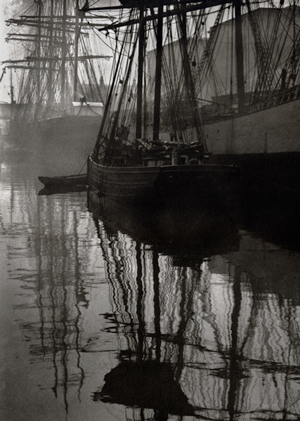Alvin Langdon Coburn
Overview
Alvin Langdon Coburn (1882 – 1966) was one of the foremost photographic artists of the modern age. His career lasted for six decades, spanning and championing the transition from pictorialism to abstraction. He became the first major photographer to emphasize the visual potential of elevated viewpoints and later made some of the first completely abstract photographs.
His most well known works were also his last taken in the United States in 1912. From the top of New York city skyscrapers he pointed the camera directly at the street, eliminating the horizon line and flattening perspective to emphasise abstraction. A meticulous printer, his unrelenting search for techniques to convey his unique vision resulted in his becoming one of the pioneers of modern photographic technique.
Featured Exhibitions

Bicycle Wheel Vortograph, 1917
Platinum palladium print
18 x 24 cm

Vortograph, 1917
Platinum palladium print
18 x 24 cm

Waterloo Bridge, 1903
Platinum palladium print
23 x 29 cm

Gravesend, 1907
Platinum palladium print
19 x 24 cm

The Flat Iron Building, evening, ca. 1911
Gum over platinum palladium
30.2 x 38.7 (34 x 42.5) cm

St. Paul’s and Cogs, ca. 1905
Gum over platinum palladium
26 x 34.7 (29.5 x 38) cm

The Octopus, 1912
Gum over platinum palladium
28.7 x 36.5 (29.5 x 39) cm

Tower Bridge and Barges, ca. 1906
Gum over platinum palladium
21.2 x 27.6 (22.8 x 28.7) cm

Regents Canal, 1904
Gum over platinum palladium
21.3 x 26.8 (23.2 x 29) cm

Spider Webs, 1906
Gum over platinum palladium
23.2 x 33.2 (28 x 35.8) cm

Auguste Rodin, 1906
Gum over platinum palladium
22.7 x 28.7 (24 x 29.7) cm

Le Penseur (George Bernard Shaw), 1906
Gum over platinum palladium
16 x 20.7 (16 x 20.7) cm

Miss Anderson, ca. 1912
Gum over platinum palladium
22 x 27.8 (22.4 x 28.1) cm